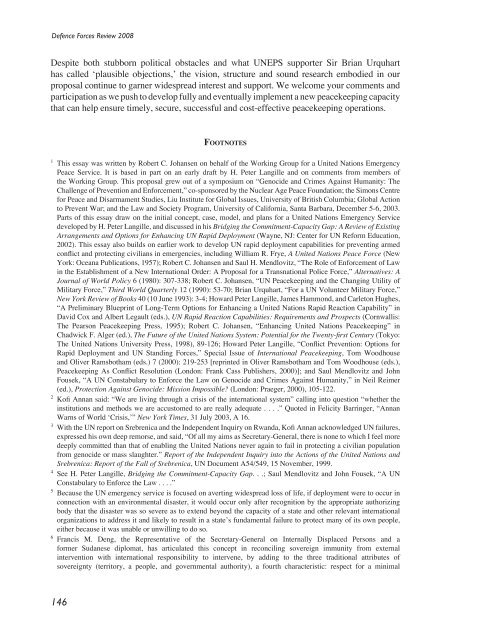Defence Forces Review 2008
Defence Forces Review 2008
Defence Forces Review 2008
Create successful ePaper yourself
Turn your PDF publications into a flip-book with our unique Google optimized e-Paper software.
<strong>Defence</strong> <strong>Forces</strong> <strong>Review</strong> <strong>2008</strong><br />
Despite both stubborn political obstacles and what UNEPS supporter Sir Brian Urquhart<br />
has called ‘plausible objections,’ the vision, structure and sound research embodied in our<br />
proposal continue to garner widespread interest and support. We welcome your comments and<br />
participation as we push to develop fully and eventually implement a new peacekeeping capacity<br />
that can help ensure timely, secure, successful and cost-effective peacekeeping operations.<br />
Fo o t n o t e s<br />
1<br />
This essay was written by Robert C. Johansen on behalf of the Working Group for a United Nations Emergency<br />
Peace Service. It is based in part on an early draft by H. Peter Langille and on comments from members of<br />
the Working Group. This proposal grew out of a symposium on “Genocide and Crimes Against Humanity: The<br />
Challenge of Prevention and Enforcement,” co-sponsored by the Nuclear Age Peace Foundation; the Simons Centre<br />
for Peace and Disarmament Studies, Liu Institute for Global Issues, University of British Columbia; Global Action<br />
to Prevent War; and the Law and Society Program, University of California, Santa Barbara, December 5-6, 2003.<br />
Parts of this essay draw on the initial concept, case, model, and plans for a United Nations Emergency Service<br />
developed by H. Peter Langille, and discussed in his Bridging the Commitment-Capacity Gap: A <strong>Review</strong> of Existing<br />
Arrangements and Options for Enhancing UN Rapid Deployment (Wayne, NJ: Center for UN Reform Education,<br />
2002). This essay also builds on earlier work to develop UN rapid deployment capabilities for preventing armed<br />
conflict and protecting civilians in emergencies, including William R. Frye, A United Nations Peace Force (New<br />
York: Oceana Publications, 1957); Robert C. Johansen and Saul H. Mendlovitz, “The Role of Enforcement of Law<br />
in the Establishment of a New International Order: A Proposal for a Transnational Police Force,” Alternatives: A<br />
Journal of World Policy 6 (1980): 307-338; Robert C. Johansen, “UN Peacekeeping and the Changing Utility of<br />
Military Force,” Third World Quarterly 12 (1990): 53-70; Brian Urquhart, “For a UN Volunteer Military Force,”<br />
New York <strong>Review</strong> of Books 40 (10 June 1993): 3-4; Howard Peter Langille, James Hammond, and Carleton Hughes,<br />
“A Preliminary Blueprint of Long-Term Options for Enhancing a United Nations Rapid Reaction Capability” in<br />
David Cox and Albert Legault (eds.), UN Rapid Reaction Capabilities: Requirements and Prospects (Cornwallis:<br />
The Pearson Peacekeeping Press, 1995); Robert C. Johansen, “Enhancing United Nations Peacekeeping” in<br />
Chadwick F. Alger (ed.), The Future of the United Nations System: Potential for the Twenty-first Century (Tokyo:<br />
The United Nations University Press, 1998), 89-126; Howard Peter Langille, “Conflict Prevention: Options for<br />
Rapid Deployment and UN Standing <strong>Forces</strong>,” Special Issue of International Peacekeeping, Tom Woodhouse<br />
and Oliver Ramsbotham (eds.) 7 (2000): 219-253 [reprinted in Oliver Ramsbotham and Tom Woodhouse (eds.),<br />
Peacekeeping As Conflict Resolution (London: Frank Cass Publishers, 2000)]; and Saul Mendlovitz and John<br />
Fousek, “A UN Constabulary to Enforce the Law on Genocide and Crimes Against Humanity,” in Neil Reimer<br />
(ed.), Protection Against Genocide: Mission Impossible (London: Praeger, 2000), 105-122.<br />
2<br />
Kofi Annan said: “We are living through a crisis of the international system” calling into question “whether the<br />
institutions and methods we are accustomed to are really adequate . . . .” Quoted in Felicity Barringer, “Annan<br />
Warns of World ‘Crisis,’” New York Times, 31 July 2003, A 16.<br />
3<br />
With the UN report on Srebrenica and the Independent Inquiry on Rwanda, Kofi Annan acknowledged UN failures,<br />
expressed his own deep remorse, and said, “Of all my aims as Secretary-General, there is none to which I feel more<br />
deeply committed than that of enabling the United Nations never again to fail in protecting a civilian population<br />
from genocide or mass slaughter.” Report of the Independent Inquiry into the Actions of the United Nations and<br />
Srebrenica: Report of the Fall of Srebrenica, UN Document A54/549, 15 November, 1999.<br />
4<br />
See H. Peter Langille, Bridging the Commitment-Capacity Gap. . .; Saul Mendlovitz and John Fousek, “A UN<br />
Constabulary to Enforce the Law . . . .”<br />
5<br />
Because the UN emergency service is focused on averting widespread loss of life, if deployment were to occur in<br />
connection with an environmental disaster, it would occur only after recognition by the appropriate authorizing<br />
body that the disaster was so severe as to extend beyond the capacity of a state and other relevant international<br />
organizations to address it and likely to result in a state’s fundamental failure to protect many of its own people,<br />
either because it was unable or unwilling to do so.<br />
6<br />
Francis M. Deng, the Representative of the Secretary-General on Internally Displaced Persons and a<br />
former Sudanese diplomat, has articulated this concept in reconciling sovereign immunity from external<br />
intervention with international responsibility to intervene, by adding to the three traditional attributes of<br />
sovereignty (territory, a people, and governmental authority), a fourth characteristic: respect for a minimal<br />
146
















